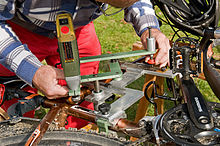ON coding
EIN - the owner identification number is used nationwide by the police, the General German Bicycle Club , the German Traffic Guard and many bicycle dealers for coding valuables. With the help of EIN, property crime can be effectively restricted and lost property returned to the owners .
EIN emerged from the project FEIN (Friedberger owner identification number) of the Friedberg police department for preventive and repressive crime fighting, which further developed an already existing procedure of the Bergisch Gladbach police.
Meaning of the EIN coding
It is possible to infer the owner of a thing immediately. The EIN marking can easily be reconstructed according to the place of residence. The EIN label is "self-explanatory" and does not require registration and therefore no data management. An EIN marking makes valuables unattractive for thieves and stolen goods and increases the risk of discovery. Lost property with an EIN mark can be returned to the owner. The EIN marking can be applied to almost all objects.
The theft of valuables can hardly be resolved if it cannot be proven who the rightful owner is. So it is not surprising that around 90% of the objects currently have to be returned to suspects after extensive stolen property exhibitions. Individual numbers of stolen objects can only be given to a very small extent (approx. 2%) after a break-in, so that the fight against crime is extremely difficult. An existing frame number according to DIN 79100 is not personal and should be supplemented with the EIN code.
- particularities
- In the case of bicycles, the frame may be unsuitable for coding if it is made of carbon or very thin-walled tubes ( light wheel ) or if something speaks against engraving for other technical reasons.
- In the case of sales (this includes donations in addition to the normal sale ), a sales receipt must always be prepared and given to the new owner so that he can prove the lawful acquisition of the item. The police only ever get to the first owner via the code, unless they have any information to the contrary.
The police and residents' registration offices can access the coding key.
Attachment
It is important to affix an ON marking that is visible to the outside and, if possible, unchangeable, on a substantial part of the object (on the housing). Additional and multiple labeling, also inside the object, is recommended. The EIN marking must be applied continuously and without any gaps (risk of falsification). The EIN marking must always follow the same system in order to avoid confusion of letters and numbers. B. would question the police investigation.
In a report by the Hessischer Rundfunk from April 2019, the coding is shown using a needle embossing device .
requirement
If owners want to have their EIN coding attached to a suitable object, they must meet the following requirements.
- Completion of the general survey declaration for the purpose of determining the EIN code and a declaration that you are the legal owner or, instead, submission of the purchase receipt showing the date of purchase.
- Submission of a document with photo showing your name and address (driver's license, passport, identity card, etc.)
It can only be attached when these requirements are met.
Systematics
| specification | Put | Remarks |
|---|---|---|
| License Plate | 1 - 3 | The official license plate number for the respective registration district of the place of residence, z. B.
Revived old license plates such as DIN (for the former Dinslaken district) are left out. |
| Community key | 2 - 3 | d. H. the final digits of the official municipality key
|
| Key no. the street | 5 |
|
| House number | 3 |
|
| Owner's initials | 2 |
|
The ADFC recommends adding a two-digit number for the year of coding. This allows you to narrow down the names that match the initials after moving and for larger residential units.
In contrast to the EIN system, in Berlin the date of birth is coded in the format DDMMYY instead of the street code and house number. Bavaria uses an abbreviation of the street name instead of the street code that is no longer maintained there.
distribution
The Hessian State Criminal Police Office has recommended the so-called Friedberger model to be used with a guideline for the labeling of bicycles, but also other valuables that are the target of property crime. The EIN labeling system is so convincing that it was adopted by 15 federal states (with a dissenting vote from the state of Berlin) in 1997, following a resolution by the “Commission for the Prevention of Crime”.
The expert commission for crime prevention of the Hessian state government (state prevention council) judged the EIN conception as an intelligent possibility to offer theft protection and also supports the concept further developed by the Friedberg police under the current name EIN-Codierung.
Web links
- ADFC FA-Technik: Code generator (EIN, nationwide)
- ADFC Hessen: [1]
Individual evidence
- ↑ Police advice: How to get your property back
- ↑ DIN CERTO: BICYCLES AND BICYCLE COMPONENTS ( Memento of the original from September 28, 2007 in the Internet Archive ) Info: The archive link was inserted automatically and has not yet been checked. Please check the original and archive link according to the instructions and then remove this notice.
- ↑ ADFC: Frequently asked questions about bicycle coding. Retrieved September 8, 2008 .
- ↑ Better protected - wheel coding discourages thieves . Hessian radio. April 4, 2019. Retrieved April 12, 2019.
- ↑ HLKA of April 10, 1997, Az. 161 - II / 301 96 - Eg.

